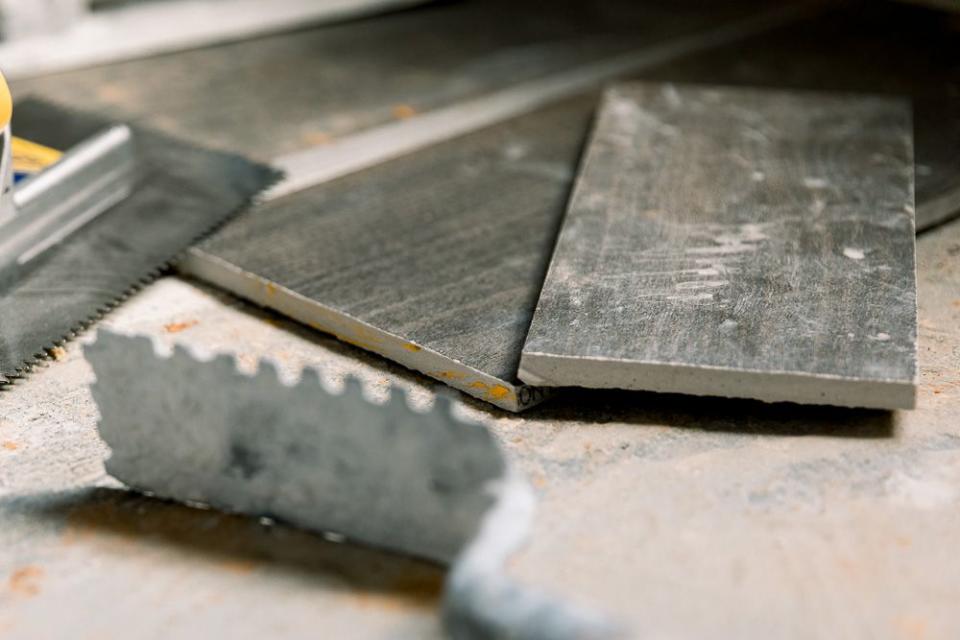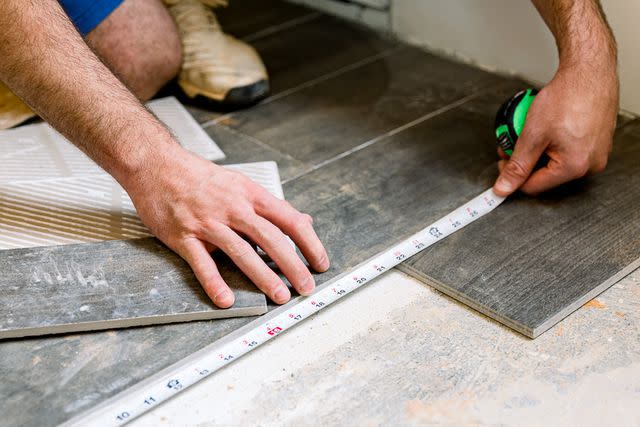How to Install Tile Over Concrete
Options for laying tile over concrete—with one clear standout

The Spruce / Ana Cadena
Floor coverings need a solid base for installation. Ceramic and porcelain tile cannot bend, flex, or shift. Complicating matters, grout—the material that fills tile seams—cannot flex or shift. Tile needs a rock-solid base and one that will not transmit cracks into the tile.
To attach tile to concrete, there are three ways to do it, with one method being the preferred choice: installing the tile with an intervening layer of uncoupling membrane.
A second method is to install a CBU or cement board on the concrete, then the tile on top of that. Attaching the tile directly to the concrete is the third and least preferable method.
Install Tile on Concrete With an Uncoupling Membrane
Pros
Uncouples tile from concrete
Smooths minor imperfections
Cons
Expensive materials
Best for professionals
It's best to take special precautions by uncoupling the tile from the concrete. The favored method of installing tile to concrete is to use an uncoupling membrane.
Schluter's Ditra and Redgard Uncoupling Mat are brands of polyethylene membranes with a grid of squares or circles embossed in the face. These are often used as waterproofing elements for building shower pans. Widely installed by tile professionals, their true value for concrete bases is as an uncoupling material.
Radiant heating can be installed under tile when using uncoupling membrane.
An uncoupling material does just that: it uncouples one thing from another. In this case, it unlocks tile from its subfloor. Acting as a buffer layer, it is flexible and does not mimic the actions of the concrete. Because subfloors can move and crack, they transmit the same to the tile above. Uncoupling material breaks this chain of transmission.
Uncoupling membranes are valuable if you anticipate any movement or cracking from the concrete floor. Generally, it is well worth the cost and the time to purchase and install an uncoupling membrane. Uncoupling membranes are not perfect, though. When the concrete dramatically tilts or cracks, no membrane can uncouple the two surfaces enough to prevent tile damage from happening.
Cost of Uncoupling Membrane
Installed uncoupling membrane costs from $3.50 to $5.00 per square foot, with an average cost of about $4.00 to $5.00 per square foot.
Shluter Ditra costs from $1.50 to $2.00 per square foot, uninstalled.
How to Install an Uncoupling Membrane
Check the floor for cracks that need to be filled.
Clean the floor thoroughly.
Lay out the uncoupling membrane and dry-fit it to the floor.
Mark the spread lines.
Mix up the setting compound,
Trowel the setting compound on the floor.
Unroll the uncoupling membrane on top of the setting compound.
Embed the uncoupling membrane.
Mix and spread more setting compound.
Lay the tile on top.
Whenever you install tile, consider using a self-leveling compound between the tile and the substrate, regardless of what it is. Also be sure to check that the floor is level and fix any low spots.
Install Tile on Concrete With a Cement Board
Pros
Provides some decoupling
Smooths uneven concrete
Cons
Raises substrate level
Crack transfer may happen
If the concrete floor exhibits cracks, gaps, holes, or other imperfections, does it make sense to put down an entire underlayment of cement board, such as HardieBacker or Durock, instead of repairing each imperfection piecemeal?
Durock, HardieBacker, and WonderBoard are all cement backer boards and are 100-percent inorganic materials that will not rot, shrink, or decompose.
In one sense, laying cement board on good concrete would be unnecessary and redundant: a cement product on a cement product. Veteran tile installers have differing opinions, with some saying that this can be done, especially if floor level needs to be raised significantly. In this type of application, attaching a CBU to the concrete is preferable to floating an entire floor's worth of mortar bed.
Most tile professionals agree that attaching a CBU to a concrete floor would be more trouble than it is worth. If anything, it would be difficult to screw the CBU into the concrete, especially with the middle layer of the thinset.
In short, installing cement board between concrete and tile is possible. But generally, it is not worth the effort and it may even result in a poor tile installation. Most importantly, the cement board is not considered to be an effective uncoupling material. While you may gain some benefits from using cement board as an uncoupling surface, a true uncoupling membrane's benefits far exceed this.
Install Tile Directly on Concrete
Pros
Less expensive
Substrate is not raised
Cons
Tile cracks are inevitable
Thinset remains on concrete
Ceramic and porcelain tile are so frequently installed at or above grade level on a cement board underlayment or directly on plywood that it almost seems novel to install tile directly on concrete.
This application does make sense, since concrete is heavy, solid, and is typically thought of as an unbending, uncompromising material. Far denser than plywood and weighing in at a hefty 75 pounds per square foot (at a six-inch depth), concrete is heavy. Not only that, concrete and tile are both mineral-based materials, so it seems natural that the two would be a perfect match.
But that only describes concrete in its perfect, unchanged state. Concrete responds poorly to foundation shifts. Groundwater pushing up from below can crack it. Tree roots routinely burrow under concrete slabs, then lift and crack them. The best mode of thought is to assume that your concrete will crack at some point in its lifespan.
The safest way to approach questionable concrete is not to cover it over with CBUs but to fix the concrete. Cracks and gaps can be filled with Portland cement-based fillers. Tile cannot be attached directly to painted concrete, as the thinset will not adhere well to the paint. Painted concrete can be made porous with sandblasting or other hard abrasive actions.
While you can install tile directly on concrete, problems may erupt when the concrete cracks or shifts. All of the movement in concrete is transferred to the tile. Cracks in concrete immediately become cracks in the tile. If you were to remove a cracked tile from concrete, undoubtedly you would see the same crack pattern below.
That said, installing tile directly on concrete is not always disastrous. Stable concrete can act as a substrate for many years.


